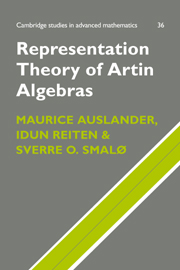Book contents
- Frontmatter
- Contents
- Introduction
- I Artin rings
- II Artin algebras
- III Examples of algebras and modules
- IV The transpose and the dual
- V Almost split sequences
- VI Finite representation type
- VII The Auslander–Reiten-quiver
- VIII Hereditary algebras
- IX Short chains and cycles
- X Stable equivalence
- XI Modules determining morphisms
- Notation
- Conjectures
- Open problems
- Bibliography
- Relevant conference proceedings
- Index
X - Stable equivalence
Published online by Cambridge University Press: 11 May 2010
- Frontmatter
- Contents
- Introduction
- I Artin rings
- II Artin algebras
- III Examples of algebras and modules
- IV The transpose and the dual
- V Almost split sequences
- VI Finite representation type
- VII The Auslander–Reiten-quiver
- VIII Hereditary algebras
- IX Short chains and cycles
- X Stable equivalence
- XI Modules determining morphisms
- Notation
- Conjectures
- Open problems
- Bibliography
- Relevant conference proceedings
- Index
Summary
The category mod Λ was introduced in Chapter IV in order to be able to define the functors Tr: mod Λ → mod Λop and Ω:mod Λ → mod Λ. Another interesting aspect of the category mod Λ is that mod Λ and mod Λ′ can be equivalent categories for seemingly rather different artin algebras Λ and Λ′. This chapter is devoted to giving various illustrations of this phenomenon. We are particularly interested in the situations where one of the algebras is either hereditary or Nakayama.
Stable equivalence and almost split sequences
We say that two artin algebras Λ and Λ′ are stably equivalent if there is an equivalence F: mod Λ → mod Λ′ between the associated module categories modulo projectives. Since we know by IV Proposition 1.9 that DTr:mod Λ → mod Λ is an equivalence of categories, it follows that Λ and Λ′ are stably equivalent if and only if the categories mod Λ and mod Λ′ of the module categories modulo injectives are equivalent. In this section we investigate properties which stably equivalent algebras have in common, including operations with which a stable equivalence F: mod Λ → mod Λ′ commutes and module theoretic properties preserved by stable equivalence. A central role is played by the behavior of almost split sequences under stable equivalence.
We start with the following easy result, showing that information on when two algebras are stably equivalent is useful for classifying algebras of finite representation type.
- Type
- Chapter
- Information
- Representation Theory of Artin Algebras , pp. 335 - 364Publisher: Cambridge University PressPrint publication year: 1995

